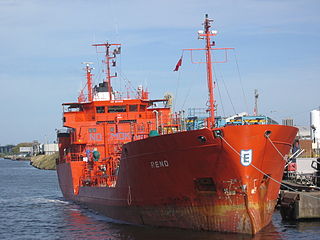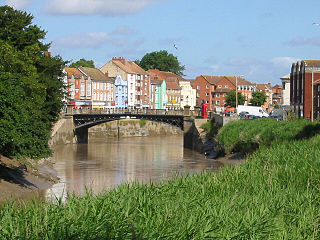Related Research Articles

The St. Lawrence Seaway is a system of locks, canals, and channels in Canada and the United States that permits oceangoing vessels to travel from the Atlantic Ocean to the Great Lakes of North America, as far inland as Duluth, Minnesota, at the western end of Lake Superior. The seaway is named for the St. Lawrence River, which flows from Lake Ontario to the Atlantic Ocean. Legally, the seaway extends from Montreal, Quebec, to Lake Erie, and includes the Welland Canal. Ships from the Atlantic Ocean are able to reach ports in all five of the Great Lakes.

The Great Lakes Waterway (GLW) is a system of natural channels and artificial canals which enable navigation between the North American Great Lakes. Though all of the lakes are naturally connected as a chain, water travel between the lakes was impeded for centuries by obstacles such as Niagara Falls and the rapids of the St. Marys River.

The River Welland is a lowland river in the east of England, some 65 miles (105 km) long. It drains part of the Midlands eastwards to The Wash. The river rises in the Hothorpe Hills, at Sibbertoft in Northamptonshire, then flows generally northeast to Market Harborough, Stamford and Spalding, to reach The Wash near Fosdyke. It is a major waterway across the part of the Fens called South Holland, and is one of the Fenland rivers which were laid out with washlands. There are two channels between widely spaced embankments with the intention that flood waters would have space in which to spread while the tide in the estuary prevented free egress. However, after the floods of 1947, new works such as the Coronation Channel were constructed to control flooding in Spalding and the washes are no longer used solely as pasture, but may be used for arable farming.

Canadian historians until the 1960s tended to focus on the history of Canada's economy because of the far fewer political, economic, religious and military conflicts present in Canadian history than in other societies. Many of the most prominent English Canadian historians from this period were economic historians, such as Harold Innis, Donald Creighton and Arthur R. M. Lower.

Runcorn Docks, originally the Bridgewater Docks, is an inland port on the Manchester Ship Canal in the town of Runcorn, Cheshire, England. It is operated by Peel Ports and handles bulk and project cargo.

The Desjardins Canal, named after its promoter Pierre Desjardins, was built to give Dundas, Ontario, easier access to Lake Ontario and the Great Lakes system of North America. Although a technological achievement and a short term commercial success, the canal was soon eclipsed by the railway, and Dundas by neighbouring Hamilton.

Lake freighters, or lakers, are bulk carrier vessels that operate on the Great Lakes of North America. These vessels are traditionally called boats, although classified as ships.

Iron-hulled sailing ships represented the final evolution of sailing ships at the end of the age of sail. They were built to carry bulk cargo for long distances in the nineteenth and early twentieth centuries. They were the largest of merchant sailing ships, with three to five masts and square sails, as well as other sail plans. They carried lumber, guano, grain or ore between continents. Later examples had steel hulls. They are sometimes referred to as "windjammers" or "tall ships". Several survive, variously operating as school ships, museum ships, restaurant ships, and cruise ships.
The Port of Alexandria is on the West Verge of the Nile Delta between the Mediterranean Sea and Mariut Lake in Alexandria, Egypt, and is considered the second most important city and the main port in Egypt. Alexandria port consists of two harbours separated by a T-shaped peninsula. The East harbour is shallow and is not navigable by large vessels. The West harbour is used for commercial shipping. The harbour is formed by two converging breakwaters.
Windoc was the name of two Great Lakes freighters owned by Canadian shipping company N.M. Paterson & Sons Ltd., with the second ship named in memory of the first in 1986. Both ships suffered similar accidents with lift bridges on the Welland Canal.

Cardiff Docks is a port in southern Cardiff, Wales. At its peak, the port was one of the largest dock systems in the world with a total quayage of almost 7 mi (11 km). Once the main port for the export of South Wales coal, the Port of Cardiff remains active in the import and export of containers, steel, forest products and dry and liquid bulks.

The Port of Albany–Rensselaer, widely known as the Port of Albany, is a port of entry in the United States with facilities on both sides of the Hudson River in Albany and Rensselaer, New York. Private and public port facilities have existed in both cities since the 17th century, with an increase in shipping after the Albany Basin and Erie Canal were built with public funds in 1825.

The Port of Bridgwater is a port, originally located in the town of Bridgwater, Somerset, England. Created under an 1845 Act of Parliament, it extends from Brean Down to Hinkley Point in Bridgwater Bay, and parts of the rivers Parrett, River Brue and River Axe. Although no ships now dock in the town, in 2001 103,613 (metric) tonnes of cargo were handled within the area of the Port Authority, most of which were stone products through the wharf at Dunball.

Algoma Mariner is a Canadian lake freighter delivered to Algoma Central on 31 May 2011. The bulk carrier was the first new Canadian-flagged vessel on the Great Lakes in 25 years. Algoma Mariner is a Seawaymax vessel, designed to carry dry bulk through the Saint Lawrence Seaway and Great Lakes. The vessel was constructed at the Chengxi Shipyard in China and is currently in service.

The Red Hook Grain Terminal is an abandoned grain elevator in the Red Hook neighborhood of Brooklyn, New York City, adjacent to the mouth of the Gowanus Canal. It is 12 stories tall, 70 feet (21 m) wide, and 429 feet (131 m) long, containing fifty-four 120-foot-tall (37 m) cement silos. As the neighborhood's tallest structure, it is highly visible from the elevated Gowanus Expressway and New York City Subway's IND Culver Line viaducts over the Gowanus Canal.

Scottish trade in the early modern era includes all forms of economic exchange within Scotland and between the country and locations outwith its boundaries, between the early sixteenth century and the mid-eighteenth. The period roughly corresponds to the early modern era, beginning with the Renaissance and Reformation and ending with the last Jacobite risings and the beginnings of the Industrial Revolution.

The Port of Noshiro is a seaport on the Sea of Japan coast of Akita Prefecture, in the city of Noshiro in the Tōhoku region of northern Honshū, Japan. It is classified as a Major Port by the Japanese government. The port has a total land area of 276 hectares.

The lake freighter MV Saginaw was launched as John J. Boland in 1953, the third vessel to bear that name. John J. Boland was owned and operated by the American Steamship Company and constructed by Manitowoc Shipbuilding Company at Manitowoc, Wisconsin. In 1999, the ship was sold to Lower Lakes Towing and renamed Saginaw. The ship is currently in service.

Cokesit was a steam cargo ship built in 1918–1919 by Guy M. Standifer Construction Company of Vancouver for the United States Shipping Board as part of the wartime shipbuilding program of the Emergency Fleet Corporation (EFC) to restore the nation's Merchant Marine. The vessel was largely employed on the East Coast of the United States to Australia route until 1928 when she was laid up. In late 1937 the ship together with several other vessels was bid on and subsequently acquired next year by the Greek tramp operator John D. Chandris to carry cargo from Australia to Greece and United Kingdom. The freighter was also renamed Adelfoi Chandris. Following the surrender of France, the ship was interned in Dakar and passed into Vichy government hands in 1940 and renamed Saint Marin. Under the terms of Nevers Agreement she eventually was transferred to Italy and renamed Catania. In early August 1943 the vessel together with several other ships was bombed and damaged in Naples harbor by the Allied aircraft.
Lake Frampton was a steam cargo ship built in 1918 by American Shipbuilding Company of Lorain for the United States Shipping Board (USSB) as part of the wartime shipbuilding program of the Emergency Fleet Corporation (EFC) to restore the nation's Merchant Marine. The vessel was employed in coastal trade during her career and collided with another steamer, SS Comus, and sank in July 1920 on one of her regular trips with a loss of two men.
References
- 1 2 3 4 5 6 7 8 9 O'Conner (1942)
- ↑ "NYS OSC General Data Document on the Port of Oswego Authority" (PDF). November 4, 2018.
- ↑ "NYS ABO List of NYS Public Benefit Corporations". November 4, 2018.
- ↑ "Port Admin Page" . Retrieved November 6, 2018.
- ↑ "Port Board Page" . Retrieved November 6, 2018.
- ↑ "NYSABO 2018 Report" (PDF). pp. 16, 29, 44. Retrieved November 6, 2018.
- 1 2 3 4 5 Zercher (1935)
- ↑ O'Conner (1942
- ↑ Port of Oswego Authority (2012)
- "A History of the First Fresh Water Port in the United States." O'Conner, W. John. 1942
- Zercher, Frederick K. "History and Development of the Port of Oswego." Diss. Syracuse University, 1935.
- "History: Port of Oswego Authority." Port of Oswego Authority.2012. Web. 6 Dec. 2012.
